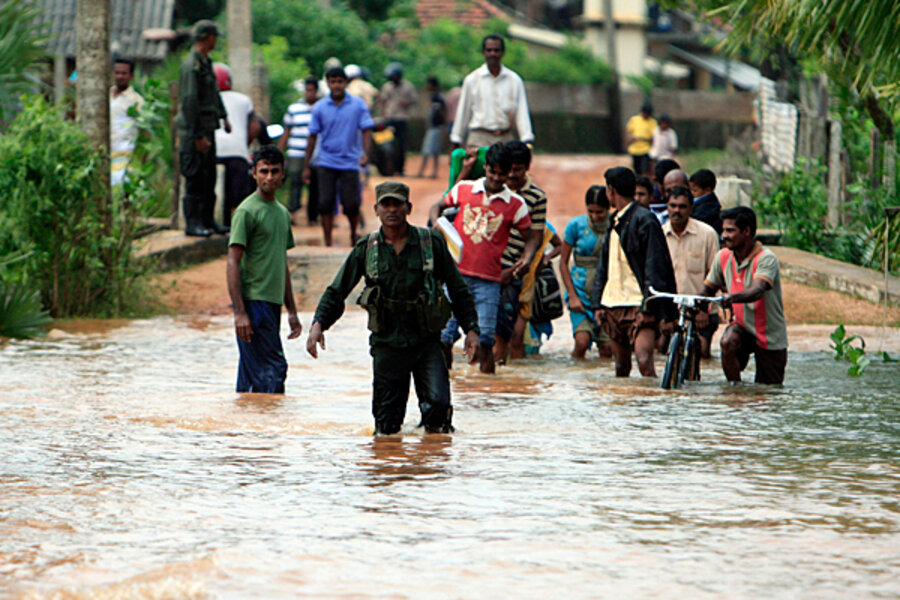Sri Lanka floods provide chance for government, Tamil reconciliation
Loading...
| New Delhi
Flooding in Sri Lanka has now affected more than a million people, many of them minority Tamils whose community recently lost a decades-long separatist fight. Government rescue and relief efforts could either help the process of reconciliation, or deepen Tamil discontent with the war’s aftermath.
More than half of those affected by the flood live in the eastern district of Batticaloa, a region hit hard by both the war and the 2004 Indian Ocean tsunami.
The 2004 tsunami presented the government in Colombo, then at war with the separatist Tamils, with a similar opportunity to repair relations. But the initial goodwill quickly broke down into squabbles over the spoils of foreign aid and unequal restrictions on beachfront redevelopment.
As this latest disaster unfolds, Colombo has won the war. But in the eyes of many Tamils and foreign governments, Colombo has yet to win the peace. The flooding disaster, if handled well, could help repair the decades of distrust.
“This has been a part of the world which has been hit so hard,” says Jennifer Hyndman, a professor at the Center for Refugee Studies at York University in Canada. “I think the government has a chance to impress the people affected by this disaster as well as much of the world and prove it is not dispossessing its Tamil people.”
Tamils suspicious of government intents
Since defeating the separatists in 2009, the government has undertaken few reconciliation measures, she says. Much of the focus has been rebuilding highways in an effort to foster economic reintegration and development.
Even that effort has been met with some suspicion, with rumors circulating that it’s designed to open up the tourist development potential of the east to the Sinhalese majority.
Meanwhile, government officials provoked ethnic divisions by pressuring Tamil-speaking students to sing the national anthem in the Sinhala language.
Floods displace 350,000
Now the floods have captured the attention of the nation, as well as international relief groups. The continued rains have prompted warnings from aid organizations that the situation will worsen. So far, 27 people have died and nearly 20,000 homes have been damaged or destroyed. The Ministry of Disaster Management provided updates on its website.
The Sri Lankan military has been dispatched to help with rescue and relief operations. The Army says it has rescued more than 450 civilians as of Thursday and prevented the breach of several lake levies. Troops are also distributing food and building temporary shelters for displaced people, which now number more than 350,000.
President Mahinda Rajapaksa told reporters Friday in Colombo the government is sparing no expense. “The relief operations are going ahead and I have told the officials to ensure that there are no delays in distributing aid.”
Rajapaksa spurred to talk about 'political solution'
According to Agence-France Presse, Mr. Rajapaksa also said he was ready “to share power at the center” with Tamils and was ready to improve on a partially implemented constitutional amendment to devolve more power to regions where many Tamils live.
“The fact that he is talking about a political solution based on constitutional reform and power sharing is good,” says Jehan Perera, the executive director of the National Peace Council, a nongovernmental organization in Colombo. “Since the end of the war, he stopped talking about it entirely because he came up with the theory that economic development by itself would suffice and end all ethnic grievances.”
But, he says, it remains to be seen what changes will actually materialize. Mr. Perera initially felt little optimism in Rajapaksa’s first response to the floods, which was a trip to visit some Sinhalese farmers in the north, ignoring the Tamil areas in the east.
The president’s announcement Friday may be prompted by a feeling of isolation from international groups as the flooding becomes a major disaster, Perera speculates. He adds the statements may also have to do with upcoming local elections and pressure over war crimes tribunals from Western governments.
Divisions between the government and the Tamil separatists in the wake of the tsunami contributed to the dismantling of a ceasefire agreement, says Professor Hyndman, a researcher whose forthcoming book, “Dual Disasters,” looks at how tsunami relief impacted conflicts in Sri Lanka and Indonesia.
This time, there’s another chance for peace-building, she says. “My hope is they will go in and build some precarious ground for trust.”
(Editor's note: The original headline was amended after publication.)





